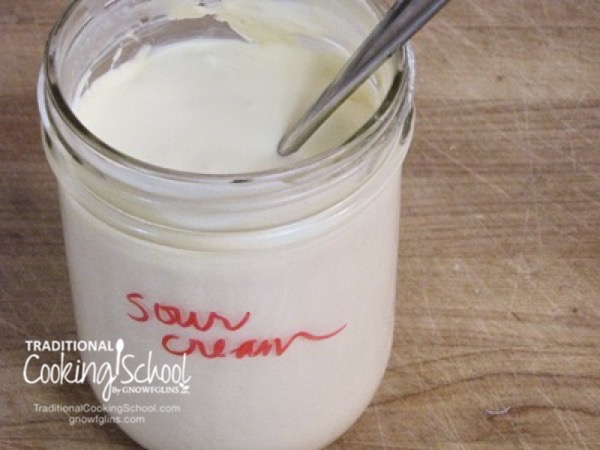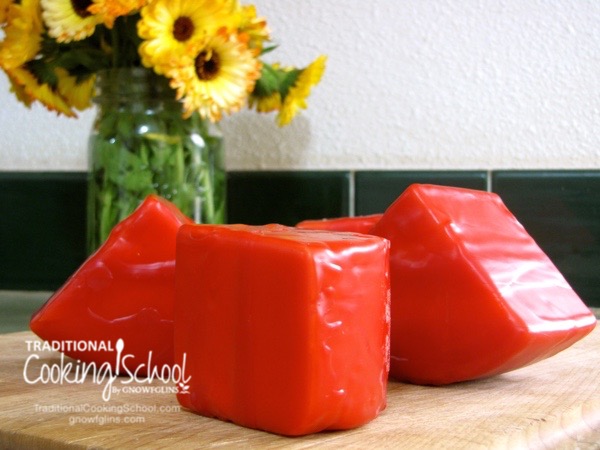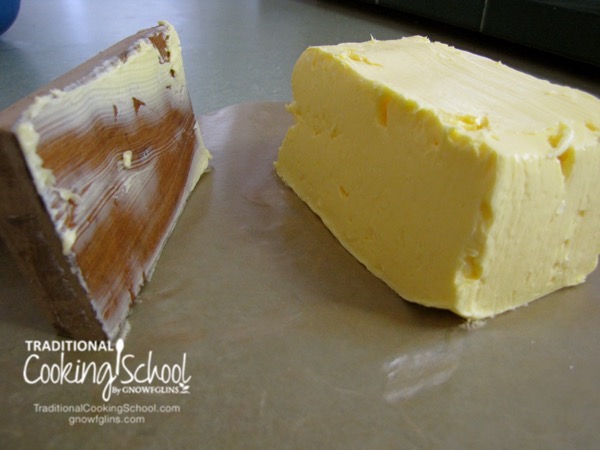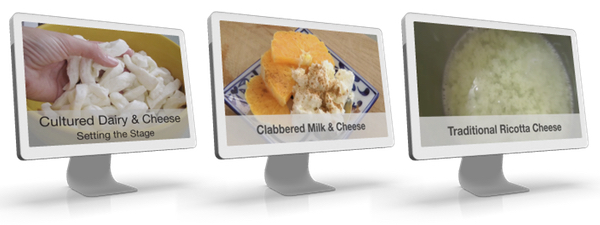
Attention: Cheese Lovers
Make Your Own Healthy Cultured Dairy and Simple Cheeses
All the tangy flavor and probiotic goodness of traditional cultured dairy and raw cheeses… without complicated techniques, hard-to-find tools or spending all day in the kitchen…

Dear Traditional Cook,
Dairy gets a bad rap.
Popular health media love to spread stories about the dangers of milk. Proteins, carbs, saturated fats, vitamins, minerals, enzymes, cholesterol, and bacteria.
Everything is in question.
The sad truth is, we have come a long way from the self-sufficient, life-giving properties of milk that our ancestors enjoyed.
Modern farming and pasteurization practices have robbed us of the nutrition and meal-time freedom that my Tata Wardeh loved to share with her children and grandchildren.
I wonder, can God’s original design for dairy be restored to us?
Here’s the good news… Clean raw milk is a living food with remarkable self-protective properties.
Even more amazing: while most foods spoil as they age, raw milk just keeps getting better.
And through the process of fermentation, several strains of bacteria transform milk into an even more digestible food: cultured cheese.
A 100% Self-Sufficient "Super" Food
Why would anyone want to culture their own cheese?
Eating raw, cultured cheeses:
- Provides over 60, fully intact and functional, enzymes to perform an amazing array of tasks and key reactions, including reducing the work load on your pancreas,
- Helps absorb and assimilate iron, calcium, phosphorus and fat-soluble vitamins,
- Makes milk proteins easier to digest (thanks to beneficial bacteria like Lactobacilli),
- Raises your metabolic rate, boosts muscle growth, reduces insulin resistance, and helps remove belly fat,
- Strengthens the immune system and discourages cancer,
- Lowers food allergy reactions,
- Prevents cavities,
- Reduces asthma symptoms,
- Builds cell membranes, activates key hormones, and protects delicate organs,
- and helps you feel full and satisfied between meals.
But why do cultured dairy and raw cheeses contain all of these amazing benefits?
The Open "Secret" About Raw Milk

Cultured dairy maintains all of these amazing benefits because they are qualities of raw, clean, pastured, unpasteurized, heirloom, whole milk.
Few people know that clean, raw milk from grass-fed cows was actually used as a medicine in the early part of the last century.
That's right. Milk straight from the udder, a sort of food “super booster”, was used as medicine to treat, and even cure some serious chronic diseases.
Nothing needs to be added to raw milk, especially that from grass-fed cows, to make it whole or better. No vitamins. No minerals. No enriching. It's a complete food.
Okay. So this is where it gets exciting…
Can You Really Make Your Own Cultured Cheese In Less Than 1 Hour?

Hi, my name is Wardee Harmon. And I’m the author of Fermenting and the Complete Idiot’s Guide to Fermenting Foods.
I am also the lead teacher for Traditional Cooking School — an online cooking school I created to honor my grandmother’s cooking traditions and preserve them so that future generations can enjoy the health benefits, flavors and fun of traditionally prepared foods.
When I first tried making my own cultured dairy and simple cheeses, I was surprised at how difficult it was to find supplies and easy instructions. I felt overwhelmed by the special equipment and complicated recipes.
But I absolutely had my heart set on making cheese from our family goat’s milk, so I did a ton of research and tried all sorts of obscure techniques. Eventually, I developed my own techniques for making raw, fresh cheeses. No aging. No special equipment required.
I got my technique down to the bare basics:
- Milk,
- Cheesecloth,
- Thermometer,
- Culture (there's one that works for pretty much all cheeses),
- Rennet, and
- Salt
And then I cut the working time down to the bare minimum. I like simple, practical, frugal, timeless techniques… so here’s my promise to you:
“Just follow the instructions, and in about an hour of hands-on-time, you’ll have fresh ricotta, queso blanco, feta, or goat cheese. Once you get the hang of it, you can break free from the rules and have fun experimenting with different spices, shapes, and recipes. Simple.”
The Magic Is In The "Cooking"
If you want to easily make your own cultured dairy and cheeses for good health, personal satisfaction, and amazing “real food” flavors that commercial cheeses just can’t imitate, then you are probably wondering…
- How do I start making cheese?
- How much cheese can I expect to get from one gallon of milk?
- I have goat's milk. Will the cow's milk recipes work for me?
- Can I make cheese without salt? If not, are some salts better than others?
- I live at a high altitude. Will I have to adjust the recipes?
- Many of the recipes have the same ingredients in them. What makes the cheeses different?
- How do I sanitize my equipment?
- Can I use the cheesecloth they sell at the grocery store?
- How do I raise the temperature of my milk without ruining it?
- How do I maintain my milk at the appropriate temperature for long periods of time?
- What do I do if the curd doesn't "set up"?
- Why do I need to cut the curds? How do I cut curds without ruining the cheese?
- Do I have to cut the curd immediately or can I let it sit longer while I do something else?
How do I know? Because these are the exact questions my students asked when I taught the Cultured Dairy and Basic Cheese eCourse live. The forum lit up with lively conversations as we debated the merits of different tools and techniques, and shared family secrets for creating the very best cheeses.
I Combined The Best From The Live Class Just For You!




So I decided to compile all of the wisdom, tips, advice and fun of our Cultured Dairy and Basic Cheese live class into an on-demand eBook and offer it to you at a deeply discounted price. It is a 19-lesson eCookbook adventure guide, 3 masterclass videos, and learning community all in one.
There’s no need to pay big money for a live class, show up at specific times, or rush through the program to keep up with other students. You proceed at your own pace, make just the recipes that interest you the most, and build your confidence as you go.
Inside you will learn…
- All the basics: the cheese-making process and how to get started — Some ingredients are mission critical… some you can fudge a little. I’ll tell you exactly where and when to insist on the best, and when you can relax… and save some cash. - Page 10
- A quick-reference guide to ingredients and tools — No time to rush to the farmer’s market? Start with the ingredients and tools you already have, check the quick guide for the perfect recipe… and get started! - Page 15
- What milk is best for making cheeses? Of course, raw, whole milk from a pastured animal is best… but I show you how to take the milk you have… and make it better. - Page 24
- How to safely jump-start the fermentation process… and eliminate the risk of spoilage. - Page 25
- How to keep all of your cheeses raw and full of probiotic goodness — Plus, the perfect cheese for when you absolutely have to cook your cheese (lasagna or quiche, anyone?) - Page 26
- The great debate: Mother cultures vs. Direct Set cultures — What works and what makes the most sense for your kitchen (and lifestyle). - Page 28
- Propagating mother cultures — Traditional and frugal… here’s how to create a starter culture that you can keep going indefinitely. - Page 97
- Waxing your own beautiful gourmet cheeses for fun and freshness — Brushing or dipping, what will you choose? - Page 101
- Hosting a kids’ tea party or a fun get-together? Here’s how to mold soft cheeses into cute, individual shapes — Start with a simple mold (or make your own) and let your imagination take you to new heights. - Page 108
- Beginner and advanced dairy kefir — Includes a quick-start primer on the tools, the method, and caring for your kefir grains… plus 6 delicious ways to serve it up today. - Page 113
- And so much more…
You showed me how easy it is!
"I’m looking forward to making my own cheddar now that you showed me how easy it is! Thanks for everything, Wardee!" ~SueAnn
Your Insider’s Guide Into The World Of Cultured Dairy And Basic Cheese… Led By The Author Of The Official Idiot’s Guide




The Cultured Dairy and Basic Cheese eBook will give you the confidence you need to easily make your own cultured dairy and cheeses for good health, personal satisfaction, and amazing “real food” flavors that commercial cheeses just can’t imitate.
If you always wanted to make your own cultured dairy and cheese, but were never quite sure how… I will guide you through the entire process.
Here are some of the recipes that you’ll learn:
- Old Fashioned Buttermilk and Sour Cream — The perfect first recipe for exploring cultured dairy… the flavor takes me right back to my Grandma’s kitchen.
- Buttermilk Biscuits topped with Cultured Butter — The process is so simple. All of the tips for culturing, churning, washing, pressing, salting and making cute molds are here.
- Room Temperature Cultured Yogurt — Toss out your old yogurt maker… you don’t have to worry about keeping your milk at a certain temperature to successfully make yogurt.
- Clabbered Milk and Cheese — No starter required. Just raw milk and a little time is all you need. (Got too much milk? Clabbered milk is perfect for feeding healthy probiotics to your chickens.)
- Katie’s Just-Like-the-Store Yogurt — “My family saves at least $300 a year by making our own yogurt, and the method creates virtually zero dishes.”
- Kefir Gets a Whole New Look: Cream, Ice Cream, Cheese, and Cheese Balls — For tummies that can’t tolerate regular ice cream, cultured ice cream could be the perfect choice. Contains up to 50 strains of beneficial bacteria and yeast, and tastes amazing!
- Traditional Ricotta Cheese — The ultimate frugal cheese… this recipe rescues every last bit of protein-rich cheese and serves it up for your family’s lasagna or quiche.
- Cottage Cheese — Flexible, easy and deliciously mild-tasting for cow’s milk or goat’s milk. I love to drizzle fresh cream over the top when I serve it!
- Feta Cheese — When you taste your first morsel, you won’t believe you made it! And, it is incredibly easy… so easy, it’s hard to mess up.
- Chard and Feta — My favorite way to use up rainbow chard in a hurry.
- Middle Eastern Fresh Cheese — Salty, chewy and best served with a plateful of other Mediterranean goodies, like pickles, olives, pocket bread, hummus or eggs.
- Queso Fresco Cheese — Fantastic flavor with very little aging. Easy to make, shreds well, and melts like a dream. You can practically make this cheese in your sleep — that’s how easy it is!
- Fresh Cheddar Cheese — Mild, pleasant, creamy and smooth — this cheese pleases everyone.
- Traditional Mozzarella Cheese — Enjoy your very own homemade traditional mozzarella cheese… top your pizza, compliment your garden tomatoes and basil in an appetizer, or toss with a leafy green salad.
- Cream Cheese — Think about all the yummy ways you can flavor it up — jams, honey, nuts, seeds, herbs, garlic, salt, cocoa, coffee... The sky’s the limit!




And expert tips like...
- The Insider’s Guide to Choosing Milk: Most people think that the best milk is determined by how it’s processed. But the truth is: The breed of the animal and the animal’s diet are huge factors in the quality of your milk (and the success that you’ll have culturing your own dairy and cheeses). I include everything you need to know on page 24.
- Success tip: In a pinch, you can use pasteurized milk to make your cheese. But don’t try this until you read page 81.
- 7 ideal places to incubate your yogurt for perfect flavor (while severely discouraging bad bacteria from getting a foothold) - Page 24
- Exactly what equipment to use, which milks culture the best, and precisely how to store your cheeses so they last for months (and get tastier as they age). - Page 26
- 12 probiotic-rich ways to use left-over whey… and 4 cooked uses for whey (including a way to use whey to extend the shelf life of your homemade breads). - Page 66
- A 4-page Special Pull-out Section: What milk to use, how to scale your starter up or down, when to add starter cultures, how to create the perfect water bath, how to make a handy-dandy thermometer clip… for free, how to use rennet and calcium chloride for perfect cheeses… every time, how to salt your cheese, how to cut the curds (it’s easier than you think), how to hang cheese, and how to wash your cheesecloth. Cut this section out, and tape it to the inside of your cabinet. It will keep you right on track. - Page 67
- 3 ways to store your Middle Eastern Fresh Cheese — in extra-virgin olive oil, in salt brine, or in airtight storage… improve the flavor of your cheese and keep it fresh for several weeks. Page 81
- Ways to re-use extra-vigin olive oil after you’ve finished your cheeses… add richer flavors to your hummus and salad dressings. - Page 81
- How to make perfect fresh cheese curds — Never too salty… always fresh and tender with just the tiniest bit of “squeak” to delight the kids with every bite. - Page 88
- Do you know how hard to press your cheese? I’ll show you how to adjust your press (and your milk) to get the perfect hardness. - Page 89
- Help! I thought cheddar cheese was ORANGE! — Spring and summer grasses are high in beta-carotene… giving cheddar its signature color. Here’s how to get the best out of summer “cheese season”. - Page 32
- Exactly how to prevent your finished mozzarella from “weeping” all over your dinner pizza. Hint: The secret is a combination of temperature and timing starting with that first jug of milk. A breeze once you know what to watch for... - Page 43
- How to stretch your mozzarella into deli-beautiful shapes like: ropes, knots, niblets, balls and braids. - Page 94
- Rescue Remedy! What to do when your mozzarella refuses to stretch. - Page 94
- 2 ways to propagate a mother culture that last for months — Choose the style that works for you: the Pure, Sterile Mother Culture or the Laid-back, Artisan Approach. - Page 97
- And much more...
Thank you for the time, effort, and quality presentation!
"How fascinating to wax our own cheese! Thank you for all the time, effort, and quality presentation in this class. I have SO appreciated it and have enjoyed learning this new skill. God bless you." ~Jennifer
A Special Offer For You

d
This is an opportunity for your entire family to enjoy the "real food" flavors that commercial cultured dairy products just can't imitate!
How much would it be worth to you to learn how to make these foods yourself?
I've priced out comparable college cooking courses (which don't cover nearly as much as we do) and they'll run you about $1000 each...
In contrast, the Cultured Dairy & Basic Cheese eBook covers 18 topics — showing you how to make your own yogurt, kefir, sour cream, butter, buttermilk, cheddar, fresh mozzarella, ricotta, queso blanco, feta, and more!
You can watch the 3 videos demonstrations over and over again, and everything is documented in the printable tutorials so you can refer to the recipes and information long into the future.
The bottom line is: What I’m offering you is much more comprehensive than a single lesson. And it costs a fraction of what you’d pay to learn each topic, one at a time. Plus, it gives you plenty of detail to get you started on the right path.
So how does it work? The Cultured Dairy & Basic Cheese eBook comes as a downloadable PDF that you can read on your computer, tablet, or phone!
3 Master Class Videos To Help You Get Started Fast!

When you order the Cultured Dairy and Basic Cheese eBook, you will be immediately be ushered into a series of 3 Master Class Videos that reveal all my cultured dairy secrets.
I’ll show you how to make clabber and ricotta cheese. After you see it once, you’ll be unstoppable!
Here are the 3 videos you'll get when you order the Cultured Dairy eBook:
- Video: About Cultured Dairy — How to choose your milk, pick a culture and get started fast! The most valuable 10 minutes you’ll spend today.
- Video: Clabber — Make your very first cheese right now. No starter needed. No special tools. Yes, it really is this simple.
- Video: Ricotta Cheese — Are you swimming in left-over whey? Here’s how to get every last bit of protein-rich goodness out of your milk. You can read about this in the eCookbook PDF… but it’s much easier if you watch it on the video.
The retail value for this collection is $21, but the courage and confidence these videos will give you is absolutely priceless.
Your Investment Is 100% Guaranteed

I am so sure that you will love the Cultured Dairy & Basic Cheese eBook that I’m offering you a 30-Day 100% Satisfaction Guarantee.
If for any reason, you decide that the Cultured Dairy & Basic Cheese eBook is not for you, is not for you then please return it and I will refund your investment.
A Whole New World Of Cultured Dairy And Cheese-Making Is Waiting For You

There’s just something special about taking milk from your family homestead or neighborhood farm, and transforming it into delicious cultured dairy and raw cheeses.
Sure, it’s good for you. But there’s something more to it…
...suddenly you are connected to generations of family members who dreamed of striking out on their own, living off the land and giving their children a better life.
There’s so much goodness packed into each attempt, each growing success, each tiny bite…
So let’s get started!
Here's What To Do Now:
Creating your own traditionally cultured dairy, fresh mozzarella, ricotta, queso blanco, feta, or goat cheese for good health, personal satisfaction, and amazing “real food” flavors that commercial cheeses just can’t imitate, starts with 3 easy steps:
- Click the Buy Now button to access your Cultured Dairy and Basic Cheese eBook,
- Watch the first Cultured Dairy Master Class Video: “About Cultured Dairy”, and
- Mix up your first batch of clabber, sour cream or cultured butter. Now just sit back, relax and wait for the curds to appear!
Here’s that Buy Now button again:
God bless you and your family,


–Wardee Harmon
Traditional Cooking School Master Teacher
GNOWFGLINS Founder
P.S. Yes! You really can make your own cultured dairy, butter, sour cream and raw cheeses in under 1 hour. Here’s your chance to nurture your family’s health, enjoy summer’s bounty all year, and reconnect with the self-sufficient, life-giving properties of milk. Act now and secure your 58% OFF deal today!
In your capable hands, you’ll be able to cook healthy, tender, delicious meals and desserts in very little time.
No, it's not set-it-and-forget-it, but it is amazingly fast, efficient, and full of flavor. I think you'll very quickly start to wonder how you ever cooked without it. Here's the Buy Now button again. I'll see you inside shortly!
Got A Question?
Here are the most common questions and answers about the Cultured Dairy & Basic Cheese eBook. If you have any other questions, click the chat bubble on this page and we'll answer right away!
No. It’s never too late to start feeling better. Why? Parents often sacrifice their own needs. And as the years go by, their health gradually declines. I want parents of any age to be able to feel better, starting today... as well as their children to get started on the right foot!
There’s some work involved in the lessons of this eBook. But I can honestly say, it’s some of the funnest work I’ve done. The cooking techniques are simple. And the recipes are mostly “mix and go.” It’s easy. And the results are amazingly effective.
No. This is the companion eBook to our online eCourse. The videos you get are pre-recorded, so you don’t have to show up anywhere, at a specific day or time. The eBook is ready for you to download immediately after purchase.
At this time, no. However, you have our permission to print a copy of the Cultured Dairy & Basic Cheese eBook PDF for personal use.
No worries. We offer a 30-day money back guarantee. Just contact us within 30 days of your purchase and we'll be happy to refund your investment, less any shipping and fulfillment costs.
We focus on the techniques of preparing real foods using traditional methods that preserve or enhance the nutritional value of the original ingredients.
There is a heavy emphasis on answering the “how” questions. However, there is always a reason for “why” we do things, and it is this “why” that is often more important than the “how.”
Our philosophy: At Traditional Cooking School by GNOWFGLINS, we believe that God is our creator and the source of all things good. God is the “why” for all that we do, including the way we cultivate, harvest, prepare and eat foods. That’s why we share our love for God and explain how we can see God’s design in our food.
This resonates with most of our students, though some participate solely for the techniques. We are happy to help you either way.
No, you don't. We advise to get the best milk you can and we teach you how to identify what that is. And then the recipes show you how to culture dairy and make simple cheeses no matter what milk you've got on hand.


